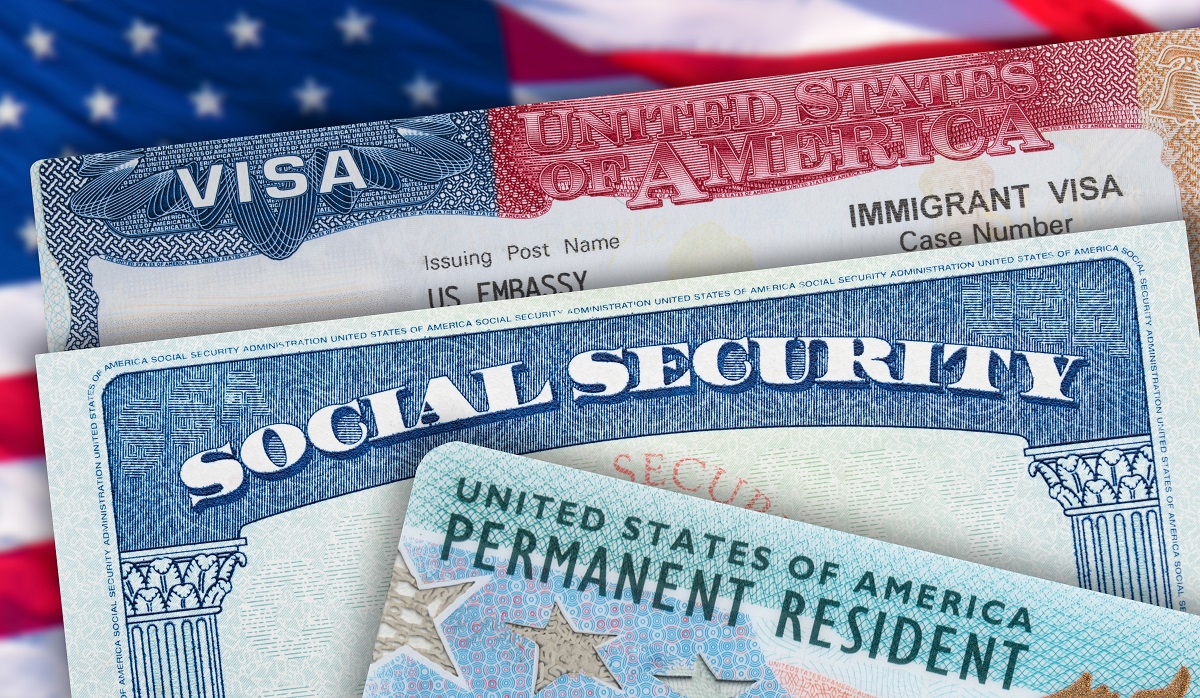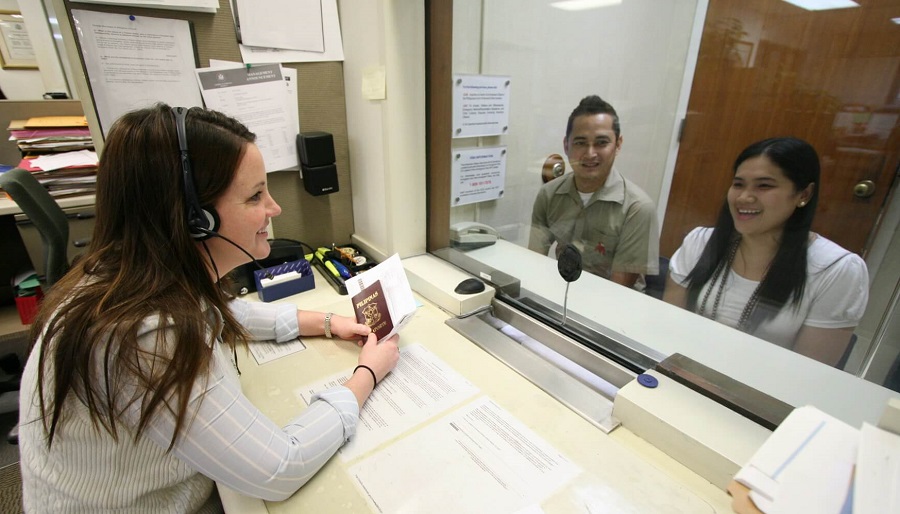
There are two fundamental ways to apply for green card (permanent resident status). Foreign nationals, who meet certain criteria, may be eligible to apply from within the United States through a process called adjustment of status. But the majority of foreign nationals apply from outside the United States at a U.S. embassy or consulate. This is known as consular processing. This article provides an overview of the family-based immigrant visa (green card) application process for consular processing.
Eligibility to Apply for a Green Card
Before getting started, you’ll need to know that you have a qualifying relationship to apply for a green card through family. Only certain relatives of U.S. citizens or lawful permanent residents (current green card holders) qualify. Here’s how each category is divided.
Immediate Relative
The immediate relative category for family-based green cards includes the spouse, unmarried children (under age 21) and parents of U.S. citizens. That's it. Because an immigrant visa is always available to immediate relatives, this is a special category. Although it takes time to obtain the green card, there isn't the long wait associated with other categories.
- IR-1: Spouse of a U.S. citizen
- IR-2: Unmarried child under 21 years of age of a U.S. citizen
- IR-3: Orphan adopted abroad by a U.S. citizen
- IR-4: Orphan to be adopted in the U.S. by a U.S. citizen
- IR-5: Parent of a U.S. citizen (petitioner must be at least 21 years old)
Family Preference
On the hand, the family preference categories generally have a wait time. That's because immigration law designates a limited number of immigrant visas each year. If there are more people requesting visas than there are visas available, this creates a wait list. The family preference category for family-based green cards includes:
- F-1 (Family First Preference): Unmarried sons and daughters of a U.S. citizen and their minor children
- F-2 (Family Second Preference): Spouses, minor children, and unmarried sons and daughters (age 21 and over) of a lawful permanent resident
- F-3 (Family Third Preference): Married sons and daughters of a U.S. citizen, and their spouses and minor children
- F-4 (Family Fourth Preference): Brothers and sisters of a U.S. citizen, and their spouses and minor children (petitioner must be at least 21 years old)
Step 1: Submit Form I-130
The entire consular process starts with the U.S. citizen or permanent resident filing a petition with the U.S. government on behalf of the foreign relative who wants to apply for a green card. Form I-130, Petition for Alien Relative, establishes a qualifying relationship with the relative. For example, a U.S. citizen could file the petition on behalf of his foreign national spouse. It is a request that U.S. Citizenship and Immigration Services (USCIS) recognize the foreign national spouse as an immediate relative of a U.S. citizen and make an immigrant visa available. Even if the petitioner is outside the United States, they may file Form I-130 to start the process.
If the I-130 petition is properly filed with the correct supporting documents, USCIS will "adjudicate" the petition. In other words, they will make a decision on the petition. For immediate relatives, this decision comes fairly quickly, about 5 to 10 months. Depending on the specific type of relationship, it may take a few months to several years for the preference categories. For a closer look at what happens after filing the petition, see the I-130 processing time.
Even once USCIS approves an I-130 petition for a family preference category, it doesn't mean the wait is over. The approval indicates you have a qualifying relationship. It does not necessarily signal the availability of an immigrant visa for preference categories. To understand the wait time, you must understand how the visa bulletin works.
Step 2: National Visa Center Processing Fees
Once USCIS approves Form I-130, they will forward the case to the National Visa Center (NVC). The NVC is part of the U.S. Department of State and will eventually transition your case to the U.S. embassy or consult that conducts the visa interview.
It might take about a month to move your case to the NVC. You’ll know the NVC has your case in their system when they send you a Welcome Letter (by email and postal mail). The NVC will also grant you online access to the case.
Before the NVC will begin processing your case, you must pay two separate fees:
- Immigrant Visa Application Processing Fee
- Affidavit of Support Fee
For more information about costs, see the consular processing fees.
Step 3: Prepare Affidavit of Support
Virtually all family-based immigrants must prove that they will not be a public charge. Consequently, they must have a financial sponsor that promises to accept financial responsibility for the person who will apply for a green card. The petitioner must prepare and submit a Form I-864, Affidavit of Support, with supporting documents. If the petitioning petitioner does not meet the income requirements, a joint sponsor can also submit an I-864 affidavit on behalf of the intending immigrant. For more information on income requirements and the I-864, read about financial sponsors for family-based green card.
By signing Form I-864, the petitioner (including any joint sponsor(s)) is agreeing to use their resources, if necessary, to financially support the principal immigrant and any dependent(s). If the immigrants receive any designated federal, state, or local means-tested public benefits, the agency providing the benefit “shall request reimbursement” from the signatory of the I-864.
Many consular processing cases are delayed significantly (or ultimately denied) because the parties cannot submit a correctly prepared Form I-864 and appropriate supporting documents. CitizenPath customers get a well-prepared Form I-864 and an easy-to-read list of personalized filing instructions that detail supporting documents. Learn more about CitizenPath’s service to prepare Form I-864.
Step 4: Apply for a Green Card
Finally, your relative may apply for a green card. It is at this point that your relative may complete the online visa application (DS-260). The DS-260 application is on the Department of State website. They will also refer to this website as the Consular Electronic Application Center (CEAC). You’ll need to know your case number in order to start.

Though you won’t be able to preview the online application to apply for a green card, you can view a sample DS-260 application. After submitting the DS-260 application through CEAC, you must print the confirmation page and take it to your interview.
Step 5: Submit Civil Documents
The application process isn't really complete until you submit your civil documents. Civil documents are records issued by the official document issuing authority in your country. Examples are birth certificates and marriage certificates.
Gather Civil Documents
The specific civil documents that you need depend on your case. The NVC will inform you of the specific civil documents necessary to support your application. These documents may or may not include:
- Birth certificates
- Marriage certificates
- Divorce decrees or death certificates
- Passports
- Military records
- Court and prison records
- Police certificates
All documents not written in English, or in the official language of the country from which you are applying, must be accompanied by certified translations.
Scan and Submit Civil Documents
The National Visa Center highly recommends that you scan and submit all documents. You may mail these documents, but it will delay the processing of your case. Specific directions will come from the NVC.
In some documents, you will need originals. Therefore, keep the original documents together in a folder that you can take the visa interview.
Once you have paid all fees, submitted the DS-260 and submitted all civil documents, you have successfully applied for a green card. The NVC will confirm by email that your case is "documentarily" complete. At this point, the NVC will begin coordinating with the U.S. embassy or consulate where you will interview.
Step 6: Immigrant Visa Interview Preparation
The NVC will schedule a visa interview at the U.S. embassy or consulate that you’ve designated. All parties, including the petitioner, intending immigrant and agent/attorney (if applicable), will be notified by email. This is your signal to prepare.
Before the interview, but not before receiving the appointment date, the intending immigrant must complete a medical examination. The exam must be with an embassy-approved doctor, also referred to as the Panel Physician. Consular officers will not accept exams conducted by other physicians. After your exam, the Panel Physician will either send the exam results directly to the embassy or give you a sealed envelope. If the doctor gives you an envelope, do not open it. Take the exam results to your visa interview and give it to the consular officer.
At this point, each embassy’s procedures can vary. You can find each embassy’s pre-interview guidelines here.
Step 7: Immigrant Visa Interview
The visa application is not formally made until a U.S. consular office interviews the immigrant visa applicant. In other words, you didn’t apply for a green card until you have interviewed. If you show up to the embassy prepared, consular interviews can be very quick.
Who Attends Consular Interview
Generally, all family members who have applied for an immigrant visa must participate in the interview. This may include you, your spouse, and any qualified unmarried children immigrating with you. In fact, the NVC’s letter will name all applicants required to participate in the appointment letter.
If your spouse and/or children will immigrate at a later date and travel separately from you, they are not required to participate in your consular interview. They will be scheduled for a separate interview appointment.
Your sponsor/petitioner does not attend the visa interview.
What to Take to Consular Interview
Refer to the appointment letter that you receive from the NVC. This letter should detail the specific items to take to your interview. The list can vary based on the country and/or embassy.
Generally, consular officers expect you to bring:
- Appointment Letter
The interview appointment letter you received from NVC. - Passport
For each applicant, an unexpired passport valid for six months beyond the intended date of entry into the United States. - Photographs
Submit two identical color photograph(s) for each applicant, which must meet the State Department photograph requirements. - DS-260 Confirmation Page
Print the confirmation page from CEAC any time after you complete your DS-260 application. - Supporting Documents
Have available the original or certified copies of all documents you submitted in Step 5.
About CitizenPath
CitizenPath provides simple, affordable, step-by-step guidance through USCIS immigration applications. Individuals, attorneys and non-profits use the service on desktop or mobile device to prepare immigration forms accurately, avoiding costly delays. CitizenPath allows users to try the service for free and provides a 100% money-back guarantee that USCIS will approve the application or petition. We provide support for the Petition for Alien Relative (Form I-130), Affidavit of Support (Form I-864), and several other immigration services.
Want more immigration tips and how-to information for your family?
Sign up for CitizenPath’s FREE immigration newsletter and
SAVE 10%
on our immigration services







